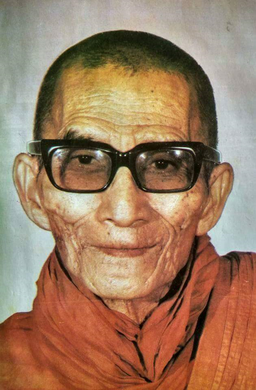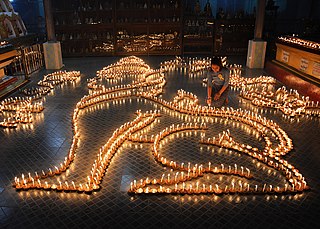Since the death of the historical Buddha, Siddhartha Gautama, Buddhist monastic communities ("sangha") have periodically convened to settle doctrinal and disciplinary disputes and to revise and correct the contents of the Buddhist canons. These gatherings are often termed Buddhist "councils". Accounts of these councils are recorded in Buddhist texts as having begun immediately following the death of the Buddha and have continued into the modern era. The earliest councils are regarded as real events by every Buddhist tradition. However, the historicity and details of these councils remains a matter of dispute in modern Buddhist studies. This is because various sources belonging to different Buddhist schools contain conflicting accounts of these events and the narratives often serve to bolster the authority and prestige of specific schools.

Vassa is the three-month annual retreat observed by Theravada Buddhists. Taking place during the wet season, Vassa lasts for three lunar months, usually from July to October.

Śāriputra was one of the top disciples of the Buddha. He is considered the first of the Buddha's two chief male disciples, together with Maudgalyāyana. Śāriputra had a key leadership role in the ministry of the Buddha and is considered in many Buddhist schools to have been important in the development of the Buddhist Abhidharma. He frequently appears in Mahayana sutras, and in some sutras, is used as a counterpoint to represent the Hinayana school of Buddhism.

The nats are god-like spirits venerated in Myanmar and neighbouring countries in conjunction with Buddhism. They are divided between the 37 Great Nats who were designated that status by King Anawrahta when he formalized the official list of nats. Most of the 37 Great Nats were human beings who met violent deaths.
The Sixth Buddhist Council was a general council of Theravāda Buddhism, held in a specially built Mahā Pāsāṇa Guhā and pagoda complex at Kaba Aye Pagoda in Yangon, Burma. The council was attended by 2500 monastics from eight Theravādin Buddhist countries. The Council lasted from Vesak (Visākha) 1954 to Vesak 1956, its completion coinciding with the traditional 2500th anniversary of the Gautama Buddha's Parinibbāna. In the tradition of past Buddhist councils, a major purpose of the Sixth Council was to preserve the Buddha's teachings and practices as understood in the Theravadin tradition.

Moggaliputtatissa, was a Buddhist monk and scholar who was born in Pataliputra, Magadha and lived in the 3rd century BCE. He is associated with the Third Buddhist council, the Mauryan emperor Ashoka and the Buddhist missionary activities which took place during his reign.

Kassapa Buddha (Pāli), is one of the ancient Buddhas whose biography is chronicled in chapter 24 of the Buddhavaṃsa, one of the books of the Pali Canon. He was the previous Buddha of this aeon before the present Gautama Buddha, though Kassapa lived long before him.

A kyaung is a monastery (vihara), comprising the domestic quarters and workplaces of Buddhist monks. Burmese kyaungs are sometimes also occupied by novice monks (samanera), lay attendants (kappiya), nuns (thilashin), and white-robed acolytes.

In Buddhism, an Arhat or Arahant is one who has gained insight into the true nature of existence and has achieved Nirvana and has been liberated from the endless cycle of rebirth.
Ten Bodhisattas refer to ten future Buddhas during their lives as bodhisattvas. They have also been referred to as successors of Gautama Buddha.

The Venerable Mingun Sayadaw U Vicittasārābhivaṃsa was a Burmese Theravāda Buddhist monk, best known for his memory skills and his role in the Sixth Buddhist Council. He was nicknamed The Book Man.

Uppātasanti Pagoda is a prominent landmark in Naypyidaw, the capital of Myanmar. The pagoda houses a Buddha tooth relic. It is nearly a same-sized replica of Shwedagon Pagoda in Yangon and stands 99 metres (325 ft) tall.

Sīvali is an arhat widely venerated among Theravada Buddhists. He is the patron saint of travel and is believed to ward off misfortunes at home such as fire or theft. His veneration predates the introduction of Theravada Buddhism into Burma.

The Thadingyut Festival, also known as the Lighting Festival of Myanmar, is held on the full moon day of the Burmese lunar month of Thadingyut. As a custom, it is held at the end of the Buddhist sabbath (Vassa) and is the second most popular festival in Myanmar after Thingyan Festival. Thadingyut festival is the celebration to welcome the Buddha’s descent from the heaven after he preached the Abhidhamma to his mother, Maya, who was reborn in the heaven.
Burmese Buddhist titles encompass numerous honorific titles conferred by the Burmese government, to recognize members of the Sangha as well as civilians. These religious titles are conferred annually by the Burmese government, in a special ceremony during the full moon day of Tabaung, at the Uppatasanti Pagoda in Naypyidaw. From 1988 to 2008, the ceremony was held at the Mahāpāsaṇa Cave, near Kaba Aye Pagoda in Yangon.

Art of Myanmar refers to visual art created in Myanmar (Burma). Ancient Burmese art was influenced by India and China, and was often religious in nature, ranging from Hindu sculptures in the Thaton Kingdom to Theravada Buddhist images in the Sri Ksetra Kingdom. The Bagan period saw significant developments in many art forms from wall paintings and sculptures to stucco and wood carving. After a dearth of surviving art between the 14th and 16th century, artists created paintings and sculptures that reflect the Burmese culture. Burmese artists have been subjected to government interference and censorship, hindering the development of art in Myanmar. Burmese art reflects the central Buddhist elements including the mudra, Jataka tales, the pagoda, and Bodhisattva.
The Venerable Taung Kalay Sayadaw Ashin Paññasãmi is a Karen Buddhist monk, and also known as a prolific writer and historian.

The Umin Thonze Pagoda is a Buddhist stupa, located in the Sagaing Hills, Myanmar. The pagoda was founded by King Tarabya I of Sagaing. It was renovated in 1643 and in 1723. In 1838, the pagoda was essentially destroyed by a major earthquake. King Pagan Min rebuilt the pagoda, completing it in 1847. It has a cave with 45 seated Buddha images arranged in a curved formation and behind them decorated with sparkling glass-works.

Bayinnaung's Bell Inscription is a bilingual inscription found on a bell which was cast by King Bayinnaung of Toungoo dynasty and hung in the middle of a road in Bago, Burma (Myanmar), during the rule of king Bayinnaung from 1554 to 1581. It is written in Burmese and Mon. The bell was first taken to Mrauk U, Arakan, Burma. In 1825 it was taken to India by Bheem Singh and now it hangs in a Hindu temple, Bhim Ghanta, QJJ9+J77, Bakner, Uttar Pradesh 207123, India.















